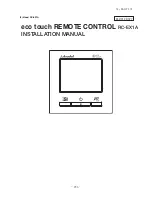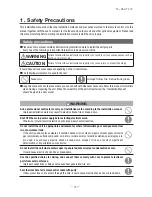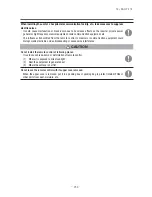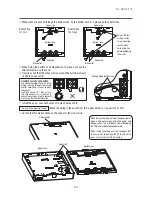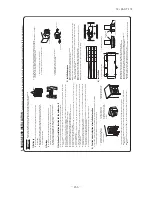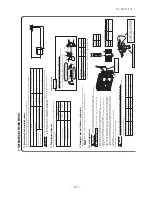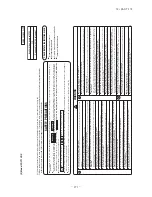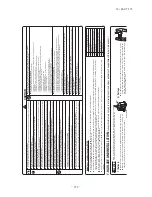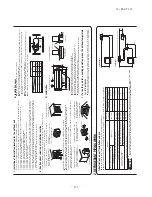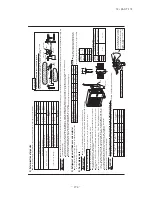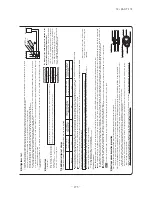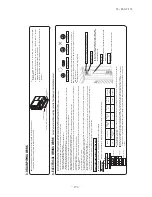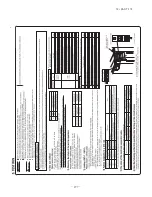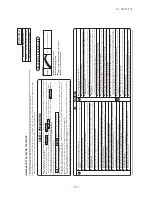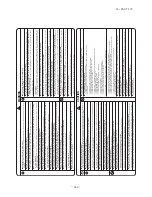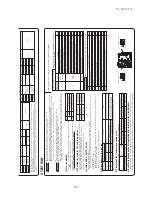
-
270
-
'12 • PAC-T-173
<Table
of
pipe
size
restrictions>
◎:
Standard
pipe
size
○:
Usable
△:
Restricted
to
shorter
pipe
length
limits
●
Please
consult
with
our
distributor
in
the
area,
if
you
need
to
recover
refrigerant
and
charge
it
again.
●
Any
combinations
of
pipe
sizes
not
listed
in
the
table
are
not
usable.
Additional charge volume (kg) = {Main pipe length (m) – Length covered without additional charge shown in the table (m)}
×
Additional charge volume per meter of pipe shown in the table (kg/m)
40
Pipe
size
50
60
Liquid pipe
ø
6.35
ø
9.52
Gas pipe
ø
12.7
ø
12.7
Usability
◎△
Maximum one-way pipe length
30
10
Length covered without additional charge
5
Usability
◎△
Maximum one-way pipe length
30
10
Length covered without additional charge
15
Usability
◎△
Maximum one-way pipe length
30
10
Length covered without additional charge
5
Additional charge volume per meter of pipe
0.02kg/m
0.06kg/m
Formula
to
calculate
additional
charge
volume
※
If
you
obtain
a
negative
figure
as
a
result
of
calculation,
no
additional
refrigerant
needs
to
be
charged.
Example)
When
an
60
is
installed
in
a
10m
long
existing
pipe
system
(liquid
Ǿ
9.52,
gas
Ǿ
12.7),
the
quantity
of
refrigerant
to
charge
additionally
should
be
(10m-5m)
x
0.06kg/m
=
0.3
kg.
NO
Are the existing units our products?
NO
NO
NO
Is the existing pipe system to reuse free of corrosion, flaws or dents?
Repair the damaged parts.
Remove those branches.
Repair the damaged parts.
Check the pipe system for air tightness on the site.
Repair the damaged parts.
NO
NO
NO
NO
No loose pipe supports
NO
YES
ST
AR
T
The existing pipe system is reusable.
The existing pipe system is not reusable.
Install a new pipe system.
YES
YES
YES
YES
YES
Are an outdoor unit and an indoor unit connected to the
existing pipe system to reuse?
Is the unit to install in the existing pipe system a
twin-triple-double-twin model?
Is the existing pipe system to reuse free of gas leaks?
(Check whether refrigerant charge was required frequently for
the system before)
Are heat insulation materials of the existing pipe system to
reuse free of peel-offs or deterioration?
(Heat insulation is necessar
y for both gas and liquid pipes)
Change the branching pipe to a specified type.
Does the existing pipe system to reuse satisfy all of the following?
(1) The pipe length is 30m or less.
(2) The pipe size conforms to the table of pipe size restrictions.
(3) The elevation difference between the indoor and outdoor units
conforms to the following restrictions.
Where the outdoor unit is above: 15m or less
Where the outdoor unit is below: 15m or less
Which of the following refrigeration oils
does the existing unit use?
Suniso, MS, Barrel Freeze, HAB, Freol,
ether oil, ester oil
Please make an
inquir
y for
reusability
.
※
Check with the flow chart developed for a case where
an existing pipe system is reused for a
twin-triple-double-twin model published as a
technical data sheet.
Change
Change is impossible.
Can Use
Can‘t
Use
Repair
is impossible.
Air tightness is
impossible.
Remove is
impossible
Repair
is impossible.
Repair
Repair
Repair
Some loose pipe supports
Air tightness is OK
Remove
5. UTILIZA
TION OF EXISTING PIPING
Check whether an existing pipe system is reusable or not by using the following flow chart.
W
ARNING
<Where
the
existing
unit
can
be
run
for
a
cooling
operation.>
Carr
y
out
the
following
steps
with
the
excising
unit
(in
the
order
of
(1),
(2),
(3)
and
(4))
(1)
Run
the
unit
for
30
minutes
for
a
cooling
operation.
(2)
Stop
the
indoor
fan
and
run
the
unit
for
3
minutes
for
a
cooling
operation
(returning
liquid)
(3)
Close
the
liquid
side
operation
valve
of
the
outdoor
unit
and
pump
down
(refrigerant
recover
y)
(4)
Blow
with
nitrogen
gas.
※
If discolored refrigeration oil or any foreign matters is discharged
by
the
blow
,
wash
the
pipe
system
or
install
a
new
pipe
system.
●
For
the
flare
nut,
do
not
use
the
old
one,
but
use
the
one
supplied
with
the
outdoor
unit.
Process
a
flare
to
the
dimensions
specified
for
R410A.
<Where
the
existing
unit
cannot
be
run
for
a
cooling
operation.>
W
ash
the
pipe
system
or
install
a
new
pipe
system.
●
If
you
choose
to
wash
the
pipe
system,
please
contact
our
distributor
in
the
area.
Aren’t there any loose pipe supports?
Are there any branch pipes with no indoor unit connected?
INST
ALLA
TION
TEST
CHECK
POINTS
After
installation
Check
the
following
points
again
after
completion
of
the
installation,
and
before
turnig
on
the
power
.
Conduct
a
test
run
again
and
ensure
that
the
unit
operates
properly
.
Explain
to
the
customer
how
to
use
the
unit
and
how
to
take
care
of
the
unit
following
the
instruction
manual.
Power
cables
and
connecting
wires
are
securely
fixed
to
the
terminal
block.
The
power
supply
voltage
is
correct
as
the
rating.
The
drain
hose
is
fixed
securely
.
Operational
valve
is
fully
open.
No
gas
leaks
from
the
joints
of
the
operational
valve.
The
pipe
joints
for
indoor
and
outdoor
pipes
have
been
insulated.
The
reverse
flow
check
cap
is
attached.
The
cover
of
the
pipe
cover
(A)
faces
downward
to
prevent
rain
from
entering.
Gaps
are
properly
sealed
between
the
pipe
covers
(A)
(B)
and
the
wall
sur
face
/
pipes.
The screw of the side cover is tightened securely.
15
15
15
Summary of Contents for FDC Series
Page 95: ... 94 12 PAC T 173 Models FDT100VF 125VF 140VF H H H H H C B A F G D G PJF000Z285 ...
Page 98: ... 97 12 PAC T 173 Models FDEN60VF 71VF C 2 C 1 A B A B D C 1 C 2 C 1 C 2 E G F B PFA003Z817 ...
Page 113: ... 112 12 PAC T 173 b Wireless remote controller RCN E1R 60 17 150 Unit mm ...
Page 278: ... 277 12 PAC T 173 ー K ...
Page 346: ... 345 12 PAC T 173 Power PCB 1BSU OVNCFS 4GRNCEG VJG 2 ...
Page 518: ... 517 12 PAC T 173 3 5 SUPER LINK E BOARD SC ADNA E F SL2NA E and SL3N AE BE to control ...
Page 519: ... 518 12 PAC T 173 ...

